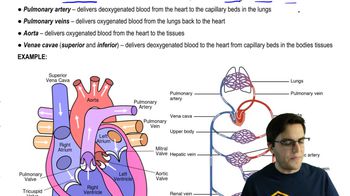Table of contents
- 1. Introduction to Biology2h 42m
- 2. Chemistry3h 40m
- 3. Water1h 26m
- 4. Biomolecules2h 23m
- 5. Cell Components2h 26m
- 6. The Membrane2h 31m
- 7. Energy and Metabolism2h 0m
- 8. Respiration2h 40m
- 9. Photosynthesis2h 49m
- 10. Cell Signaling59m
- 11. Cell Division2h 47m
- 12. Meiosis2h 0m
- 13. Mendelian Genetics4h 44m
- Introduction to Mendel's Experiments7m
- Genotype vs. Phenotype17m
- Punnett Squares13m
- Mendel's Experiments26m
- Mendel's Laws18m
- Monohybrid Crosses19m
- Test Crosses14m
- Dihybrid Crosses20m
- Punnett Square Probability26m
- Incomplete Dominance vs. Codominance20m
- Epistasis7m
- Non-Mendelian Genetics12m
- Pedigrees6m
- Autosomal Inheritance21m
- Sex-Linked Inheritance43m
- X-Inactivation9m
- 14. DNA Synthesis2h 27m
- 15. Gene Expression3h 20m
- 16. Regulation of Expression3h 31m
- Introduction to Regulation of Gene Expression13m
- Prokaryotic Gene Regulation via Operons27m
- The Lac Operon21m
- Glucose's Impact on Lac Operon25m
- The Trp Operon20m
- Review of the Lac Operon & Trp Operon11m
- Introduction to Eukaryotic Gene Regulation9m
- Eukaryotic Chromatin Modifications16m
- Eukaryotic Transcriptional Control22m
- Eukaryotic Post-Transcriptional Regulation28m
- Eukaryotic Post-Translational Regulation13m
- 17. Viruses37m
- 18. Biotechnology2h 58m
- 19. Genomics17m
- 20. Development1h 5m
- 21. Evolution3h 1m
- 22. Evolution of Populations3h 53m
- 23. Speciation1h 37m
- 24. History of Life on Earth2h 6m
- 25. Phylogeny2h 31m
- 26. Prokaryotes4h 59m
- 27. Protists1h 12m
- 28. Plants1h 22m
- 29. Fungi36m
- 30. Overview of Animals34m
- 31. Invertebrates1h 2m
- 32. Vertebrates50m
- 33. Plant Anatomy1h 3m
- 34. Vascular Plant Transport1h 2m
- 35. Soil37m
- 36. Plant Reproduction47m
- 37. Plant Sensation and Response1h 9m
- 38. Animal Form and Function1h 19m
- 39. Digestive System1h 10m
- 40. Circulatory System1h 49m
- 41. Immune System1h 12m
- 42. Osmoregulation and Excretion50m
- 43. Endocrine System1h 4m
- 44. Animal Reproduction1h 2m
- 45. Nervous System1h 55m
- 46. Sensory Systems46m
- 47. Muscle Systems23m
- 48. Ecology3h 11m
- Introduction to Ecology20m
- Biogeography14m
- Earth's Climate Patterns50m
- Introduction to Terrestrial Biomes10m
- Terrestrial Biomes: Near Equator13m
- Terrestrial Biomes: Temperate Regions10m
- Terrestrial Biomes: Northern Regions15m
- Introduction to Aquatic Biomes27m
- Freshwater Aquatic Biomes14m
- Marine Aquatic Biomes13m
- 49. Animal Behavior28m
- 50. Population Ecology3h 41m
- Introduction to Population Ecology28m
- Population Sampling Methods23m
- Life History12m
- Population Demography17m
- Factors Limiting Population Growth14m
- Introduction to Population Growth Models22m
- Linear Population Growth6m
- Exponential Population Growth29m
- Logistic Population Growth32m
- r/K Selection10m
- The Human Population22m
- 51. Community Ecology2h 46m
- Introduction to Community Ecology2m
- Introduction to Community Interactions9m
- Community Interactions: Competition (-/-)38m
- Community Interactions: Exploitation (+/-)23m
- Community Interactions: Mutualism (+/+) & Commensalism (+/0)9m
- Community Structure35m
- Community Dynamics26m
- Geographic Impact on Communities21m
- 52. Ecosystems2h 36m
- 53. Conservation Biology24m
40. Circulatory System
Circulatory and Respiratory Anatomy
Problem 2
Textbook Question
Blood returning to the mammalian heart in a pulmonary vein drains first into the
a. Left atrium
b. Right atrium
c. Left ventricle
d. Right ventricle
 Verified step by step guidance
Verified step by step guidance1
Understand the flow of blood in the mammalian circulatory system, which consists of two main circuits: the pulmonary circuit and the systemic circuit.
Recognize that the pulmonary veins carry oxygenated blood from the lungs back to the heart.
Identify the chambers of the heart: the left atrium, right atrium, left ventricle, and right ventricle.
Recall that the pulmonary veins deliver oxygenated blood to the left atrium of the heart.
Conclude that blood returning to the heart in a pulmonary vein drains first into the left atrium.
 Verified video answer for a similar problem:
Verified video answer for a similar problem:This video solution was recommended by our tutors as helpful for the problem above
Video duration:
3mPlay a video:
Was this helpful?
Key Concepts
Here are the essential concepts you must grasp in order to answer the question correctly.
Pulmonary Circulation
Pulmonary circulation is the part of the cardiovascular system that carries deoxygenated blood from the right side of the heart to the lungs and returns oxygenated blood to the left side of the heart. This process is crucial for gas exchange, allowing blood to release carbon dioxide and absorb oxygen in the lungs.
Recommended video:
Guided course

Gas Exchange and Circulation
Heart Chambers
The mammalian heart consists of four chambers: two atria and two ventricles. The atria are the upper chambers that receive blood, while the ventricles are the lower chambers that pump blood out of the heart. Understanding the flow of blood through these chambers is essential for comprehending the heart's function in circulation.
Recommended video:
Guided course

Heart Physiology
Left Atrium
The left atrium is one of the four chambers of the heart, specifically responsible for receiving oxygenated blood from the lungs via the pulmonary veins. This chamber then transfers the blood to the left ventricle, which pumps it out to the systemic circulation, supplying oxygen to the body.
Recommended video:
Guided course

Heart Anatomy

 6:28m
6:28mWatch next
Master Gas Exchange and Circulation with a bite sized video explanation from Jason
Start learningRelated Videos
Related Practice
Multiple Choice
An individual suffering from __________ has irregularly shaped erythrocytes and may suffer from severe pain and organ swelling.
985
views
